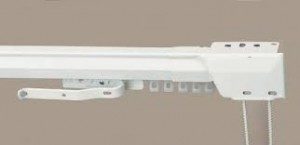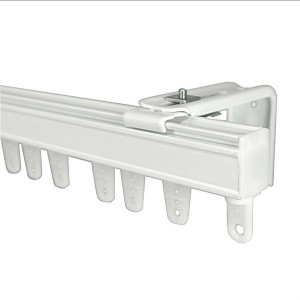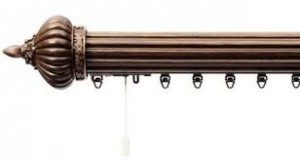Things to consider when choosing functional drapery hardware.
I’ve had a number of calls lately with people having problems opening & closing their drapes. It is essential that the proper hardware be chosen for each project. Choosing the proper draper hardware can make opening & closing your drapes either a nightmare or a breeze.
At Elegance In Draperies, we take into consideration the size, weight and function of your new draperies as we select the appropriate hardware. After all, who wants brand new drapes that you can’t easily open and close?
There are basically two types of functional hardware – cord-draw and hand-draw.
Drapes that are cord-draw are installed on a traverse rod (decorative or standard). For light-duty drapes & sheers, the standard rod, which is your basic white rod, with plastic glides will work just fine. When you have heavier drapes or very tall drapes, you need to upgrade to a ball-bearing rod, or a rod with wheeled glides. The glides on standard traverse rods drag across the rod, while ball-bearing carriers or wheeled glides roll across the rod, with virtually no friction. Most ball-bearing rods use an extruded aluminum track, adding strength & durability. We just replaced a rod 11’ wide, 21’ up in the air. My client’s drapes were blackout lined, very heavy & fully functional. The original designer used a standard rod. The rod was inferior as it could not handle the weight of the drapes. After replacement, they glide beautifully! Many special-order lines of drapery hardware, offer decorative wood rods with upgraded components. Most decorative traverse rods will have ball-bearing glides.
For hand-draw applications, the most common is using a decorative rod with rings, and batons (or wands) to pull the drapes open & closed. This works great with slick or polished finishes, but becomes a problem when the finish on the hardware is not slick enough to allow the rings to move smoothly across the rod. Antiqued or multi-step finishes tend to have this problem. Glossy painted and iron rods tend to operate easier. A few weeks ago I had a client with nearly new drapes, about 10’ tall, on a hand draw rod. The hardware was iron, but with an antiqued finish. The drapes were so heavy & so tall that even with oversized batons, she still couldn’t get them closed at night. We are replacing her hand-draw rods with decorative traversing rods.
New “Zip-track” or “channel track” rods make operation much easier. They still use ball-bearing glides, but use batons to pull the draperies, instead of a cord. Since the ball-bearing glides roll smoothly, it makes hand-drawing them easy. Of course, the mounting height of the drapes must still be taken into consideration.
I do not recommend grommet-top drapes to be hand drawn except in certain situations. As a general rule, they are hard to open & close. Rod-pocket and tab-top drapes are also best as stationary drapes.
Let us help cover your bases on your next project! If you have an existing window treatment that just doesn’t work right, call and let us make your drapes a breeze to operate!

Standard cord-traverse rods work great for light weight drapes.

Heavy-duty rods are needed for heavy or oversized drapes. The ball-bearing glides roll easily through the extruded aluminum track.

Zip-track, or channel track rods work well with ball-bearing glides & batons.

Decorative wood cord-traverse rods are beautiful, strong & can handle almost anything!
